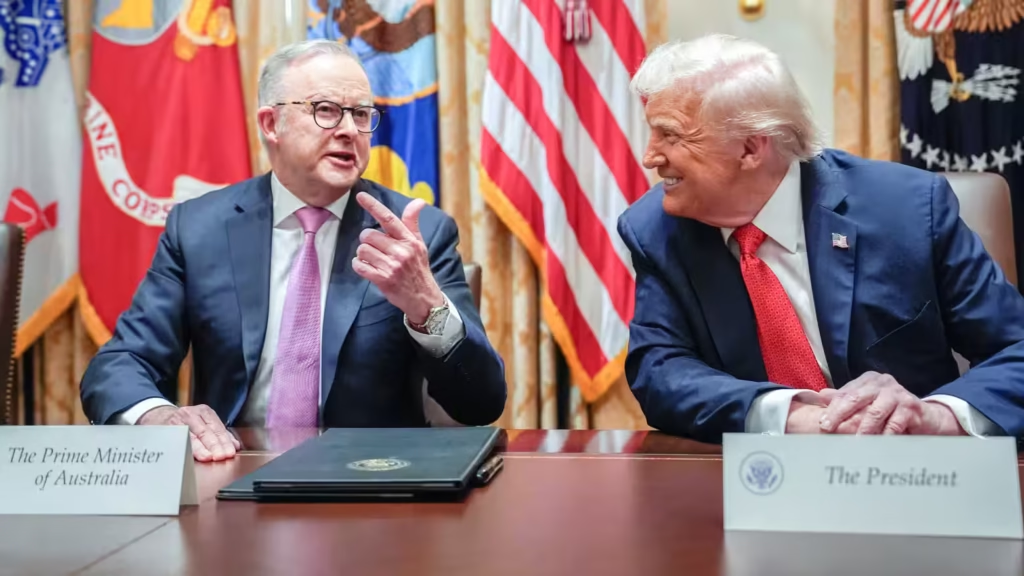New Delhi: In a bold move to reshape the global fight for essential resources, U.S. President Donald Trump and Australian Prime Minister Anthony Albanese sealed a landmark critical minerals agreement on October 20, 2025. This pact targets China’s overwhelming control over vital materials like rare earth elements, which power everything from electric cars to military hardware. Dubbed the U.S.-Australia Critical Minerals Framework, the deal promises $8.5 billion in ready-to-launch projects and marks a new era of allied cooperation against supply chain vulnerabilities.
The signing unfolded in the White House Cabinet Room amid a mix of diplomacy and sharp banter. Trump, known for his unfiltered style, took a moment to address Australia’s U.S. ambassador, Kevin Rudd. Recalling Rudd’s 2020 social media post labeling Trump as “the most destructive president in history” – a comment Rudd later removed – the president quipped, “I don’t like you either, and I probably never will.” Despite the tension, the leaders exchanged warm greetings and focused on shared goals: securing minerals for defense, clean energy, and tech innovation.
This agreement arrives at a pivotal time. Trade frictions with China are heating up, especially ahead of Trump’s upcoming summit with Chinese President Xi Jinping in South Korea. Beijing’s recent moves, like requiring government approval for exporting magnets with even tiny traces of rare earths from Chinese sources or tech, have alarmed Western leaders. These rules, announced earlier this month, give China sweeping leverage over the tech supply chain, from smartphones to fighter jets.

Understanding Critical Minerals: The Hidden Backbone of Modern Life
Critical minerals sit at the heart of today’s technologies, yet their scarcity and uneven distribution pose massive risks. These are raw materials indispensable for clean energy transitions, advanced manufacturing, and national security. Think lithium for batteries in electric vehicles, cobalt for smartphone screens, nickel for wind turbine magnets, and copper for wiring in renewable grids. A special group within this category, rare earth elements, includes 17 metals crucial for high-tech gadgets, defense systems, and green tech.
Why the fuss? These minerals face “high supply risk” because they’re scarce or controlled by just a handful of nations. For instance, the Democratic Republic of Congo alone provides about 70% of the world’s cobalt, exposing global markets to political instability and economic shocks. Such geographic concentration turns supply chains into ticking time bombs, vulnerable to disruptions from conflicts or trade barriers.
Enter China’s role: The Asian giant processes 85-95% of the world’s rare earths and dominates mining for many others, like gallium and germanium. In a tactic critics call “resource weaponization,” Beijing has curbed exports of these materials. Last December, it halted gallium shipments to the U.S., hitting American chipmakers hard. This isn’t just business – it’s strategic maneuvering, flooding markets with cheap exports to crush competitors or tightening supplies to extract concessions.
The U.S.-Australia deal directly counters these plays. It sets up a “minimum price floor” for critical minerals, a long-sought tool by Western miners. This mechanism prevents China from dumping excess stock to tank prices and drive rivals out of business. Trump boasted to reporters, “In about a year from now, we’ll have so much critical mineral and rare earths that you won’t know what to do with them.” Albanese echoed the optimism, calling it an “$8.5 billion pipeline that we have ready to go,” elevating the U.S.-Australia bond to unprecedented heights.
Breaking Down the Deal: Investments, Projects, and Safeguards
At its core, the framework commits each nation to pump $1 billion into mining and processing ventures over the next six months. Together, that’s $2 billion in fresh capital targeting deposits valued at $53 billion. Details on exact minerals or sites remain under wraps for now, but the focus is clear: ramp up supplies for defense manufacturing and energy security.
The U.S. Export-Import Bank (EXIM) wasted no time, issuing seven letters of interest worth over $2.2 billion for Australian projects. These backers include Arafura Rare Earths, Northern Minerals, Graphinex, Latrobe Magnesium, VHM, RZ Resources, and Sunrise Energy Metals. Spanning rare earths to magnesium and beyond, these initiatives support U.S. re-industrialization in high-tech sectors like aerospace, communications, and advanced batteries. EXIM’s statement emphasized resilience: “Counter China’s export dominance and ensure Western supply-chain stability.”
On the defense front, the Pentagon is funding a gallium refinery in Western Australia, producing 100 tonnes annually. This directly addresses China’s export ban, securing a key input for semiconductors and military radars.
Beyond funding, the pact streamlines operations. Both countries pledge to slash permitting timelines for mines, refineries, and support infrastructure. They’ll collaborate on geological mapping, mineral recycling, and blocking sales of critical assets on national security grounds. This last point nods to China’s global shopping spree, like snapping up the planet’s biggest cobalt mine in Congo from U.S. firm Freeport-McMoRan back in 2016.
Albanese highlighted three project types: U.S. funding for Australian processing plants, joint pricing strategies, and unified rules for reviewing company sales in the sector. The White House framework, though concise, underscores urgency – a “next-level” partnership forged during Trump’s first term but supercharged now.
Australia’s Mineral Riches and the Path to Diversification
Australia boasts world-class mining prowess and vast reserves, second only to China in rare earths per U.S. Geological Survey data. Yet, like the U.S., it leans on Beijing for processing raw ores into usable forms. This deal flips the script, funneling investments to build domestic capabilities and create “preferential access” to Australia’s strategic stockpiles.
Markets reacted swiftly. Shares in Arafura Rare Earths leaped 7.7%, while Iluka Resources climbed over 3%. Lynas Rare Earths, already a U.S. Defense Department contractor with a Texas project, saw pre-meeting buzz. These gains signal investor faith in the pact’s power to unlock value.
Experts like Pini Althaus, CEO of Cove Capital and founder of USA Rare Earth, stress the price floor’s game-changing potential. “Taking away that arrow in China’s quiver to manipulate pricing is crucial,” he said. China has long used overproduction to bankrupt global foes, but this floor shields projects from boom-bust cycles. Althaus, with 25 years in mining, warns of the long haul: China holds a 40-year lead, so the West needs decades – and diverse partners – to catch up. He eyes Central Asia’s untapped reserves, where Soviet-era groundwork could speed development in places like Kazakhstan and Uzbekistan.
Gracelin Baskaran from the Center for Strategic and International Studies calls the $3 billion joint injection (including EXIM) “unprecedented” for its speed. Still, she notes Australia can’t fill every gap alone; U.S. investments in domestic players like MP Materials, plus Canadian firms Trilogy Metals and Lithium Americas, are vital. In return, Washington has snagged ownership stakes, blending public support with strategic equity.
Broader Geopolitical Ripples: AUKUS, India, and China’s Shadow
The minerals pact intertwined with security talks, spotlighting AUKUS – the 2023 U.S.-UK-Australia submarine alliance valued at A$368 billion ($239.46 billion). Initially inked under President Joe Biden, it equips Australia with U.S. nuclear-powered subs starting 2032, followed by joint builds with Britain. Trump’s team reviewed it for “America First” fit, sparking Aussie jitters over delays.
But Trump gave a green light: “Full steam ahead… no more clarifications.” Navy Secretary John Phelan described tweaks to the original framework, ironing out ambiguities for all three nations. Australia is stepping up, with $2 billion this year to U.S. shipyards and plans to service Virginia-class subs at its Indian Ocean base from 2027. The 10-month wait for an official Trump-Albanese sit-down – after a brief UNGA sideline chat – eased with this nod, despite Pentagon nudges for higher Aussie defense spending.
China fired back predictably. Foreign Ministry spokesperson Guo Jiakun decried AUKUS for risking “nuclear proliferation” and “arms races,” while vaguely urging resource nations to stabilize chains without “normal economic and trade cooperation” disruptions. On the minerals front, Beijing sidestepped direct commentary but implied markets should dictate flows.
Globally, this fits a diversification push. India, for one, launched its National Critical Mineral Mission to blend homegrown and overseas sourcing. The 2023 Mines and Minerals Amendment Act greenlights exploration, while New Delhi joined the U.S.-led Minerals Security Partnership (MSP) Finance Network for ethical supply chains.
White House economic advisor Kevin Hassett framed it starkly: “Australia is really going to be helpful in making the global economy less exposed to rare earth extortion from the Chinese.” Treasury Secretary Scott Bessent added, “China is a command-and-control economy… we and our allies will neither be commanded nor controlled.” As Trump eyes new tariffs and tech export curbs, this pact signals a united front.
Long-Term Stakes: From Extortion to Empowerment
The real win? Breaking free from “extortion,” as Hassett put it. U.S. firms, hooked on Chinese rare earths for EVs, aircraft engines, and radars, face blackmail risks amid escalating tariffs. The deal accelerates a multi-year pivot: immediate Australian buys could ease shortages, but full independence demands patient mine-building.
Albanese, fresh off a May reelection where his center-left Labor Party shunned “Trumpism” for collaborative progress, stressed mutual benefits. “Australians have chosen to face global challenges… looking after each other while building for the future,” he said post-victory. His team, including resources and industry ministers, brought geological know-how to the table.
Trump’s Florida return on October 19 set the stage for this D.C. drama, blending domestic boasts with international arm-twisting. Photos captured the handshake: Trump and Albanese amid aides, agreement in hand – a visual of trans-Pacific solidarity.
As shares surge and refineries rise, this framework isn’t just ink on paper. It’s a blueprint for a less China-dependent world, blending minerals with military muscle. Yet challenges loom: environmental pushback on mining, tech hurdles in processing, and Beijing’s inevitable countermeasures. For now, though, the U.S. and Australia stand taller, minerals in hand, ready to redefine supply chains for the 21st century.
FAQs
1. What is the US-Australia Critical Minerals Framework, and why does it matter right now?
The framework is a new agreement signed on October 20, 2025, by President Donald Trump and Prime Minister Anthony Albanese to boost secure supplies of vital minerals like rare earths, lithium, and cobalt. It commits each country to $1 billion in investments over six months for mining and processing projects, unlocking an $8.5 billion pipeline of ready initiatives. This counters China’s 85-95% control over rare earth processing and recent export curbs on materials like gallium, which threaten US tech and defense sectors. With trade tensions rising ahead of Trump’s Xi Jinping summit, the deal ensures diversified sources for electric vehicles, wind turbines, and military radars, reducing risks from geographic bottlenecks—like Congo’s 70% cobalt monopoly.
2. How does the deal tackle China’s market manipulation tactics?
China has long flooded markets with cheap minerals to bankrupt competitors, then restricted exports for leverage—such as blocking US gallium shipments last December. The framework introduces a “minimum price floor” to stabilize costs, protecting Western miners from these boom-bust cycles. It also speeds up permitting for new mines and refineries, funds geological mapping and recycling, and blocks national security-risky asset sales (a subtle jab at China’s global buyouts, like the 2016 Congo cobalt mine grab). Plus, the US Export-Import Bank is fronting $2.2 billion for seven Australian firms, including Arafura Rare Earths and Northern Minerals, to build resilient processing hubs.
3. What role do rare earth elements play, and how will this agreement change their supply?
Rare earths are a subset of critical minerals—17 metals essential for magnets in EVs, smartphones, and defense gear like aircraft engines. Australia holds massive reserves (second to China), but lacks processing muscle. The pact targets $53 billion in deposits, with the Pentagon building a 100-tonne gallium refinery in Western Australia. Trump predicts a supply surge “in about a year,” while Albanese eyes US-backed plants Down Under. This builds on prior US investments in firms like MP Materials and Lynas Rare Earths, aiming for self-reliance after decades of Chinese “extortion,” as White House advisor Kevin Hassett calls it.
4. How does this tie into broader security pacts like AUKUS, and what’s Australia’s commitment?
The minerals deal synced with AUKUS reaffirmation—a $239 billion US-UK-Australia submarine pact for nuclear-powered vessels starting 2032. Trump greenlit it “full steam ahead” after a review, with Navy Secretary John Phelan tweaking ambiguities for mutual wins. Australia is chipping in $2 billion yearly to US shipyards and will service Virginia-class subs from 2027 at its Indian Ocean base. China slammed AUKUS for fueling “arms races,” but the combo strengthens Indo-Pacific defenses while securing minerals for sub tech. Albanese’s team, including resources ministers, brought mining expertise to the table.
5. What’s next for global efforts, including other countries like India?
This pact fits a worldwide diversification wave. India launched its National Critical Mineral Mission for domestic and foreign sourcing, backed by the 2023 Mines and Minerals Amendment Act, and joined the US-led Minerals Security Partnership for ethical chains. Experts like Pini Althaus warn of China’s 40-year head start, urging US investments in Central Asia’s reserves (e.g., Kazakhstan). Treasury Secretary Scott Bessent vows no “command-and-control” from Beijing, while markets buzz—Arafura shares jumped 7.7%. Long-term, expect faster mine builds, recycling tech, and allied pricing rules to make supply chains less volatile.

